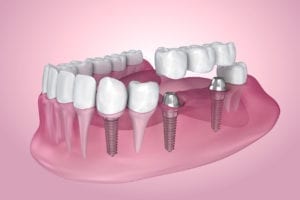 In addition to being harmful to your self-esteem, missing teeth can cause a variety of problems, from difficulty speaking normally to difficulty eating and poor nutrition. Fortunately, the world of modern dentistry has several excellent options for tooth replacement available.
In addition to being harmful to your self-esteem, missing teeth can cause a variety of problems, from difficulty speaking normally to difficulty eating and poor nutrition. Fortunately, the world of modern dentistry has several excellent options for tooth replacement available.
One of the most simple and reliable methods is the dental bridge. The skilled dental professionals at Bella Smiles in Long Island, NY want to take a moment to explain the benefits of bridges for restoring a healthy smile.
What is a Dental Bridge?
A bridge is a prosthesis (artificial replacement part) that replaces a missing tooth and is anchored in place by the healthy natural teeth around it. In dental terms, the replacement tooth is called a “pontic” (from the French word “pont” meaning bridge). The healthy adjacent teeth — termed the abutments — support the pontic on either side. The completed restoration spans the gap in your teeth like a bridge across a canyon.
The teeth that will form the abutment must be specially prepared to support the pont. To do this, they must be crowned or “capped.” The crown is installed in the same way as if the abutment teeth needed crowns due to tooth decay or damage.
First, their enamel is removed, to allow the crown to fit over the tooth completely while maintaining a lifelike appearance. The crowns on the abutment teeth will support the false tooth (pontic) in between. The pontic is really just another crown but without a live natural tooth underneath.
Building a Bridge
If you are missing only one tooth, your bridge will still require three crowns: two to cover the abutment teeth and one in between (the pontic). This configuration is called a three-unit bridge.
If multiple teeth are missing, more crowns will be needed on more abutment teeth to support the bridge. Your Bella Smiles dentist will determine this number by considering how many teeth are missing, the size, length and stability of the abutment tooth roots, and the location in the mouth where the bridge is being placed. So if you are missing three teeth, four abutment teeth may be necessary, thereby creating a seven-tooth bridge.
What to Expect
Getting bridgework completed usually requires two visits to the dentist’s office. At the first visit, local anesthetic will be administered by your dentist and your abutment teeth will be prepared for crowning as described above. Molds of your prepped teeth will be taken to prepare three-dimensional models of your teeth, used to construct the crowns. A temporary bridge will be placed before you leave the office to help you resume normal eating and talking.
When your permanent bridge is ready, you will come back in for your second visit to have it placed. You may need some time to become accustomed to the feel of the new bridge against your tongue, lips, and cheeks, but will eventually come to accept it as part of your own teeth.
Caring for your Bridge
Crowned teeth require the same routine care as your natural teeth. Dentists recommend brushing twice daily and flossing every day to reduce the build-up of plaque and bacteria. Flossing will be slightly more challenging as you must weave the floss under the connected crowns to clean between them. It is even more important for you to see your Bella Smiles dentist for routine examinations and cleanings if you have a bridge since it can last for decades if cared for properly.
Dental Bridges in Long Island, NY
If you are in the Long Island, NY area and would like to discuss tooth replacement options with a skilled professional dentist or even just have a routine teeth cleaning, schedule online with your Bella Smiles dentist today. We have locations in Riverhead, Roslyn and Nesconset for your convenience.
